Spending time in the garden or park is soothing and relaxing. However, certain parks might provide more beauty than others. Therefore, choosing the best plants for parks, streets, and landscapes is vital. Native plants are special because they grow naturally or without much human help. They can grow wild on the plains and in various parks, gardens, and backyard areas.
Kansas is home to a wide variety of native plants, including several species of oak, hickory, and maple. These plants are well-adapted to Kansas’ climate and growing conditions and provide essential habitats and food to various wildlife species.
Kansas is also home to several rare and endangered plant species, such as the milkweed and Orchid. However, efforts are underway to protect and conserve these plants and to promote their growth and restoration in the state.
Read on to learn about nine of Kansas’ native plants.
1. American Hophornbeam (Ostrya virginiana)

The American Hophornbeam is known for its durability and strength in making furniture and other wooden items.
©Erika J Mitchell/Shutterstock.com
The American Hophornbeam, also known as the ironwood tree, is a deciduous tree that originates from eastern North America. Usually reaching heights of 30 to 40 feet, it is a medium-sized tree with a spread of 20 to 30 feet. The tree’s bark is distinctive gray-brown and is often profoundly furrowed. The leaves are alternately arranged and are dark green, turning yellow in the fall, with an attractive bark and fall color.
The American Hophornbeam is known for its durability and strength in making furniture and other wooden items. However, the tree is affected by pests such as the Hophornbeam bark borer and the Hophornbeam leaf miner.
Birds and animals depend on the tree’s tiny, nut-like fruits as a significant source of nutrition. At the same time, various animals may hide under its thick foliage for protection.
2. Hackberry (Celtis occidentalis)
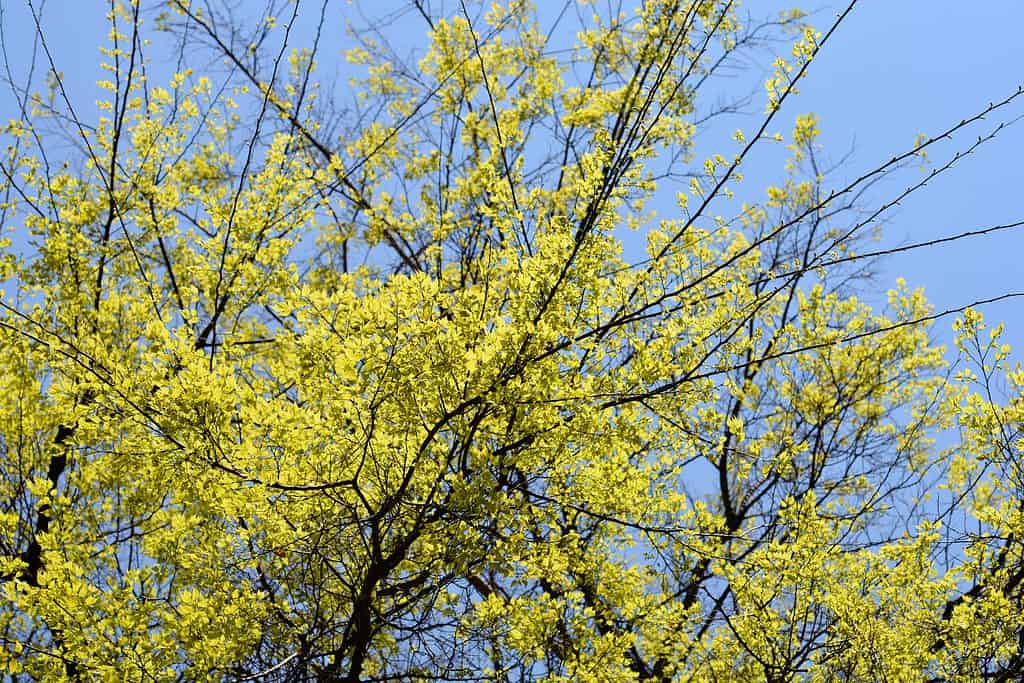
The hackberry is a versatile tree that can grow in various soil types and climates.
©Nahhana/Shutterstock.com
It is commonly known as hackberry or nettle tree and is a deciduous tree native to Kansas. Additionally, it is a medium-sized tree with moderate or fast growth of two to three feet per year. The tree grows to a height of 50 to 80 feet with a spread of 30 to 50 feet.
The tree bark is smooth when young but dark to light gray with warty bumps as it matures. Its leaves are alternately arranged and dark green, turning yellow during fall.
The hackberry is a versatile tree that can grow in various soil types and climates. However, it prefers well-drained soils and moderate rainfall. The tree can tolerate drought and urban conditions, making it a popular choice for urban landscapes.
The tree’s small, berry-like fruits are an essential food source for birds and small mammals, while its dense foliage provides cover for various wildlife. Humans also value the tree for its attractive appearance and many constructions and furniture-making uses.
Native Americans used the hackberry for multiple purposes, including making baskets and other household items.
The hackberry’s enemies are the hackberry emperor moth and the hackberry nipple gall. The pests can cause leaf damage and deformities but generally do not significantly threaten the tree’s health.
3. The White Oak (Quercus alba)
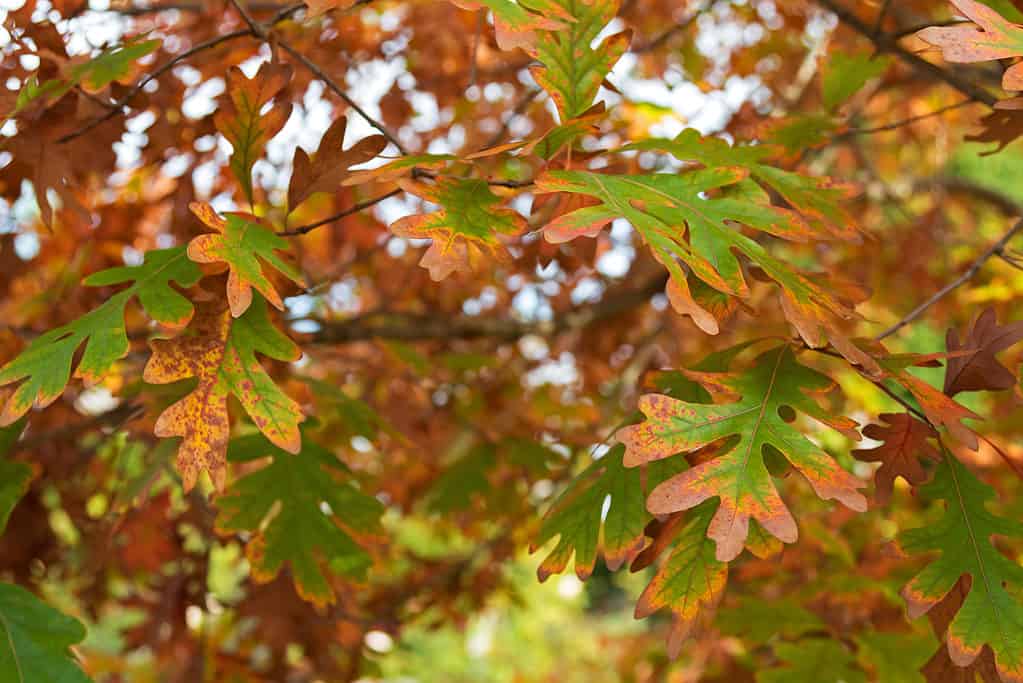
The white oak is a slow-growing tree, and it can take up to 50 years to reach its maximum height of 80 to 100 feet.
©sasimoto/Shutterstock.com
You can distinguish the white oak with its white bark and dark green leaves with strongly lobed margins.
The white oak is a slow-growing tree, and it can take up to 50 years to reach its maximum height of 80 to 100 feet. However, once the tree reaches maturity, it can live for up to 500 years. The tree has a deep and extensive root system, allowing it to thrive in various soils.
The white oak prefers well-drained, fertile soils and full sun. It is also drought-tolerant and can survive in areas with low levels of rainfall.
The tree’s wood is solid and durable and is used to make various products, including furniture, flooring, and barrels.
Native Americans used the tree’s bark to make multiple items, including baskets. They also used it as medicine. Today, white oak is still used for lumber and other wood products and is also popular as an ornamental tree.
Did you know that the white oak is the state tree of Illinois? It was also chosen as America’s national tree by Congress in 2004.
4. Northern Red Oak (Quercus rubra)

The northern red oak grows best in well-drained, moist soils and prefers moderate rainfall. However, the tree is drought resistant.
©Pawel Horazy/Shutterstock.com
The red oak, also known as the champion oak, is a deciduous tree native to eastern North America. It is a large tree with a moderate to fast growth rate of two to three feet per year. Typically, it spans 40 to 45 feet and has a height of 60 to 80 feet. The tallest known northern red oak is located in Monroe, NY, and stands 80 feet tall.
The tree has a distinctive dark reddish or greenish-brown, turning black to brown with age, and is often profoundly furrowed. Moreover, its leaves are alternately arranged and are dull dark green, turning reddish-brown in the fall.
The northern red oak grows best in well-drained, moist soils and prefers moderate rainfall. However, the tree is drought resistant. In addition, the northern red oak is generally resistant to pests and diseases, although it can be affected by oak wilt and other fungal infections. These diseases can cause leaf damage and kill the tree if left untreated.
The tree’s acorns are an essential food source for birds and small mammals, while its dense foliage covers multiple wildlife.
Native Americans used the northern red oak for various purposes, including making baskets, weapons, and other household items.
The northern red oak is the state tree of New Jersey. It was named the state’s tree in 1950 due to its significance to the state’s environment and economy.
5. Eastern Red Cedar (Juniperus virginiana)
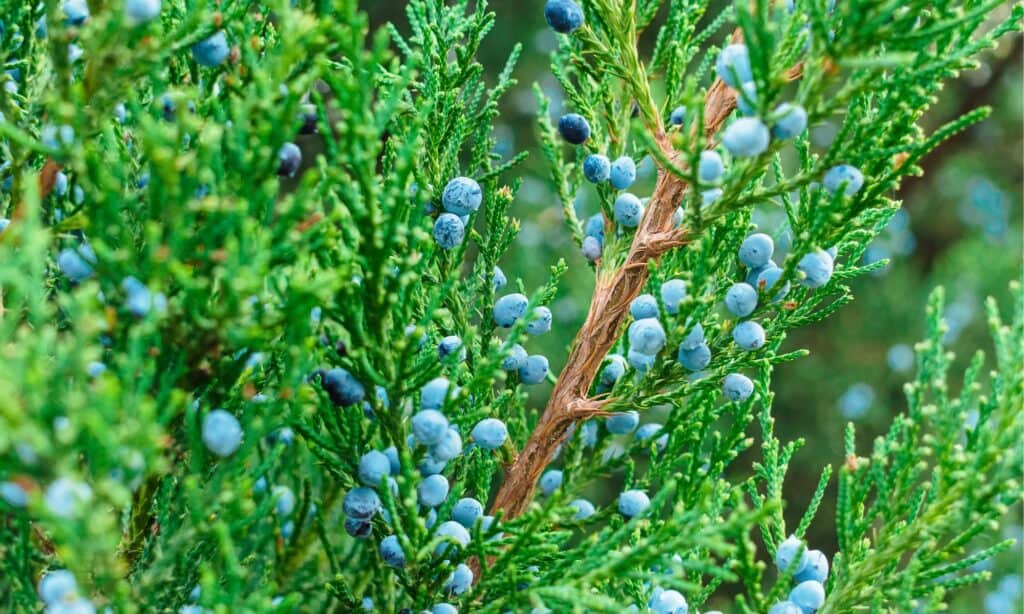
The eastern red cedar prefers well-drained, sandy soils and moderate rainfall.
©iStock.com/Yuliya Shauerman
Red juniper or fragrant cedar are the other common names for the eastern red cedar. This tree ranges from tiny to medium, with a moderate development rate of 13 to 24 inches yearly, depending on the growing environment.
The tree grows 40 to 50 feet high, 12 and 15 feet wide. The tree’s bark is reddish-brown and often covered with a fine, white powder on the stems. It has blue-green to dark-green leaves and a distinctive triangular shape.
The eastern red cedar prefers well-drained, sandy soils and moderate rainfall. The tree is also tolerant of drought and urban conditions, making it a popular choice for urban landscapes. The tallest known eastern red cedar is located in Virginia and stands at 85 feet tall.
The eastern red cedar can be affected by cedar apple rust and other fungal infections, which can cause leaf damage and kill the tree if left untreated.
Birds and small mammals depend on the tree’s tiny, berry-like fruits for sustenance, and a variety of animals may hide from predators thanks to its thick foliage.
Moreover, Native Americans used the eastern red cedar for multiple purposes, including making baskets, weapons, and other household items.
Due to its conical shape, it is a popular Christmas tree species. In addition, its attractive blue-green foliage and pleasant aroma make it a favorite among those looking for a natural tree to decorate during the holiday season.
6. American Sycamore (Platanus occidentalis)
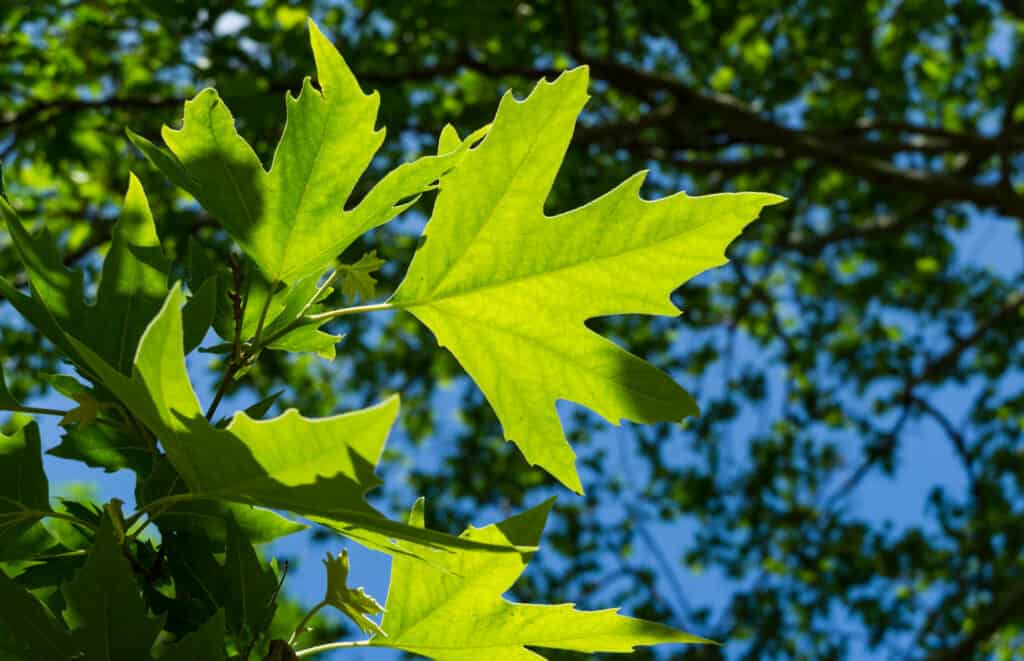
The American smoke tree produces small, round fruits about the size of peas.
©iStock.com/Marina Denisenko
It is a tiny deciduous tree endemic to the eastern United States. It is well-known for its lovely purple or reddish-pink blooms, which appear in early summer or late spring.
During the growth season, the leaves of the American smoke tree are green, but they turn yellow or purple in the fall. The tree typically grows to 15 to 25 feet and has a similar spread at maturity.
The term “smoke tree” refers to the spikelet of the tree, which is “smoky” pink and can completely cover the tree at its height.
The American smoke tree produces small, round fruits about the size of peas. These fruits are green when they first appear but turn brown as they mature.
Many gardens and parks cultivate the trees as attractive plants. It is also sometimes used in landscaping and as a street tree. The tree is also popular with birds and other wildlife attracted to its flowers and fruits.
7. White Fringe Tree (Chionanthus virginicus)
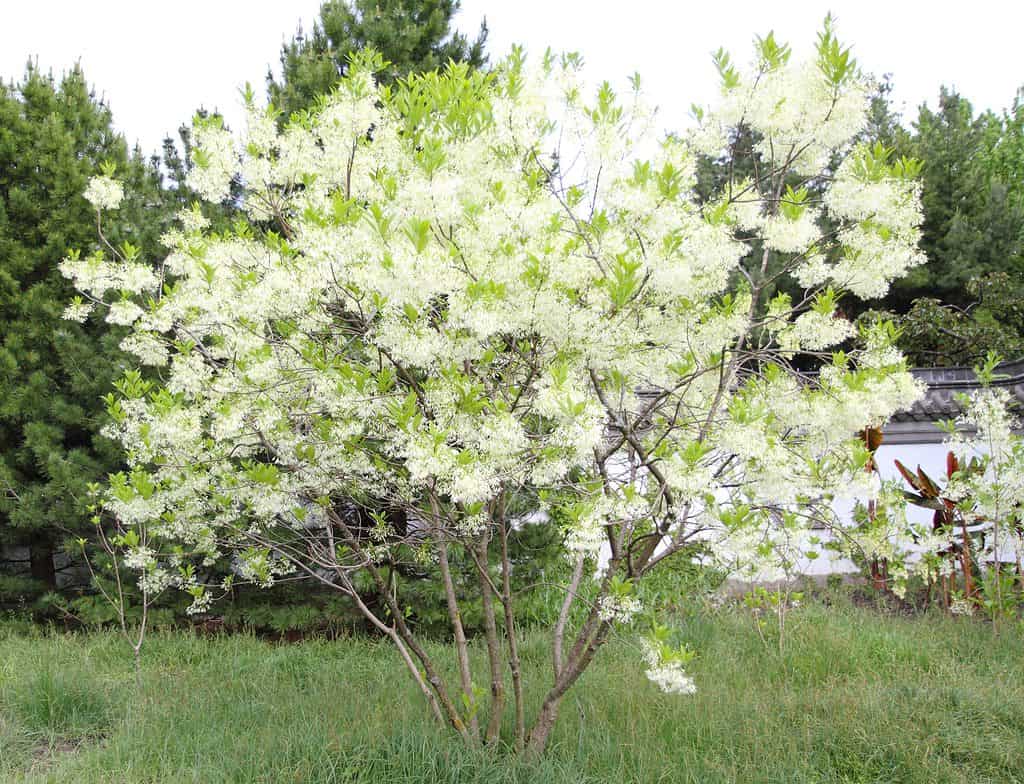
The white fringe tree’s bark is gray-brown and often covered with a white, powdery substance.
©Cephas/CCBY3.0 – License
Native to Kansas, the white fringe tree is also known as the granny graybeard or the old man’s beard. The standard height and spread are 15 to 20 feet and 10 to 15 feet, respectively. However, the trees in the wild are much taller.
The white fringe tree’s bark is gray-brown and often covered with a white, powdery substance. The leaves are alternate and dark green, turning yellow in the fall.
The white fringe tree can grow in various soil types and climates, although it prefers moist, well-drained soils and moderate rainfall. It can be affected by fringe tree scale and other insect pests.
The tree’s small, berry-like fruits are an essential food source for birds and small mammals, while its dense foliage provides cover for various wildlife. Humans also value trees for their attractive appearance and many uses in landscaping and ornamental plants.
The Chinese believe the white fringe tree’s flowers have medicinal properties. They use them to treat various conditions, including coughs, colds, and asthma.
8. The Green Ash (Fraxinus pennsylvanica)
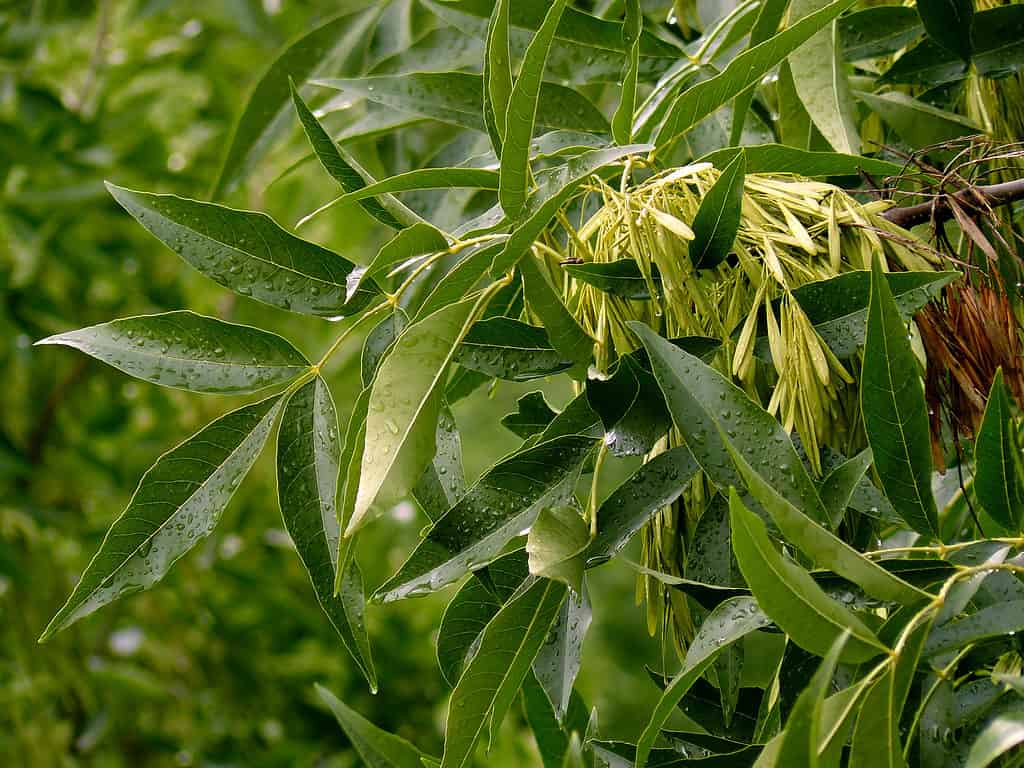
The Green ash tree’s bark is grey-brown with narrow ridges and deep furrows.
©Denis Pogostin/Shutterstock.com
This plant, also known as red ash or swamp ash, is a deciduous tree native to Kansas. It is a medium-sized tree with a moderate to rapid growth rate that reaches heights of 50 to 70 feet and spreads from 25 to 30 feet.
The tree’s bark is grey-brown with narrow ridges and deep furrows. The leaves are 10 to 12 inches long, opposite, and dark green, turning yellow in the fall. The green ash grows best in moist, well-drained soils and prefers moderate rainfall.
It can tolerate many conditions, including drought and urban conditions.
9. Kentucky Coffee Tree (Gymnocladus dioicus)

The Kentucky coffee tree prefers deep, moist soil and can tolerate many conditions, including dry, alkaline soil.
©simona pavan/Shutterstock.com
This is a large tree species native to Kansas that can reach 100 feet tall and about 50 feet wide. Its bark is gray and furrowed. The tree produces clusters of greenish-white flowers in the spring, followed by large, bean-like pods containing seeds.
Native Americans used the tree’s seeds as a coffee substitute, which is how the tree got its name.
The Kentucky coffee tree prefers deep, moist soil and can tolerate many conditions, including dry, alkaline soil. It is drought-tolerant and can survive in areas with as little as 20 inches of rainfall per year. The tree has few natural enemies, such as leaf rollers and two-spotted spider mites.
Ecologically, the Kentucky coffee tree provides food and shelter to various birds and mammals, including squirrels and cardinals. The tree also has some medicinal uses for humans. The bark, leaves, and seeds treat multiple conditions, including fever and stomach pain.
Because the Kentucky coffee tree is dioecious, each tree is either a man or a female. However, unique seed pods are produced exclusively by female plants.
It is known as the “Kentucky coffee tree” because early Kentucky settlers used its seeds to brew a hot beverage to replace coffee.
In Conclusion
Did you know that 95 % of forests in Kansas are private, while 5% are under the control of public agencies? Introducing native trees into your landscape can provide several benefits, including improving air and water quality, providing habitat for wildlife, and adding beauty and value to your property.
If you are interested in introducing native trees into your Kansas landscape, choosing species well-suited to the local climate and growing conditions is essential. Additionally, bright trees welcome a large variety of birds, thus beautifying your home, town, or street.
Up Next…
The photo featured at the top of this post is © Nahhana/Shutterstock.com
Sources
- Gardening Solutions, Available here: https://gardeningsolutions.ifas.ufl.edu/plants/trees-and-shrubs/trees/red-cedar.html
- States Symbols USA, Available here: https://statesymbolsusa.org/symbol-official-item/new-jersey/state-tree/red-oak
- Kansas Department of Agriculture, Available here: https://www.agriculture.arkansas.gov/forestry/urban-community-forestry/tree-recommendations/
Thank you for reading! Have some feedback for us? Contact the AZ Animals editorial team.






